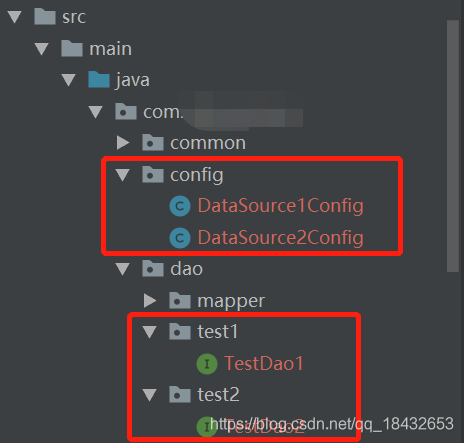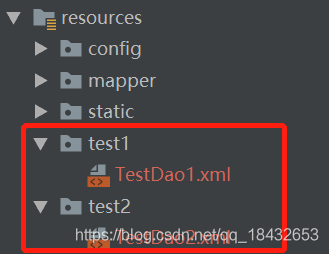这篇文章给大家分享的是有关SpringBoot怎么同时装配两个相同类型数据库的内容。小编觉得挺实用的,因此分享给大家做个参考,一起跟随小编过来看看吧。同时装配两个相同类型数据库1.配置文件:spring: profil
这篇文章给大家分享的是有关SpringBoot怎么同时装配两个相同类型数据库的内容。小编觉得挺实用的,因此分享给大家做个参考,一起跟随小编过来看看吧。
1.配置文件:
spring: profiles: active: dev datasource: primary: jdbc-url: jdbc:sqlserver://localhost:1111;DatabaseName=DB1 driverClassName: com.microsoft.sqlserver.jdbc.SQLServerDriver type: com.alibaba.druid.pool.DruidDataSource username: root passWord: root secondary: jdbc-url: jdbc:sqlserver://localhost:1111;DatabaseName=DB2 driverClassName: com.microsoft.sqlserver.jdbc.SQLServerDriver type: com.alibaba.druid.pool.DruidDataSource username: root password: root2.配置类:
①主配置类:DataSourceConfigPrimary
@Configuration@MapperScan(basePackages = "com.message.dao.primary", sqlSessionFactoryRef = "primarySqlSessionFactory")public class DataSourceConfigPrimary { // 将这个对象放入Spring容器中 @Bean(name = "primaryDataSource") // 表示这个数据源是默认数据源 @Primary // 读取application.properties中的配置参数映射成为一个对象 // prefix表示参数的前缀 @ConfigurationProperties(prefix = "spring.datasource.primary") public DataSource getDateSourcePrimary() { return DataSourceBuilder.create().build(); } @Bean(name = "primarySqlSessionFactory") // 表示这个数据源是默认数据源 @Primary // @Qualifier表示查找Spring容器中名字为test1DataSource的对象 public SqlSessionFactory primarySqlSessionFactory(@Qualifier("primaryDataSource") DataSource datasource) throws Exception { SqlSessionFactoryBean bean = new SqlSessionFactoryBean(); bean.setDataSource(datasource); bean.setMapperLocations( // 设置mybatis的xml所在位置 new PathMatchingResourcePatternResolver().getResources("classpath:mapper/primary/*.xml")); return bean.getObject(); } @Bean("primarySqlSessionTemplate") // 表示这个数据源是默认数据源 @Primary public SqlSessionTemplate primarySqlSessionTemplate( @Qualifier("primarySqlSessionFactory") SqlSessionFactory sessionFactory) { return new SqlSessionTemplate(sessionFactory); }}②次配置类:DataSourceConfigSecondary
@Configuration@MapperScan(basePackages = "com.message.dao.secondary", sqlSessionFactoryRef = "secondarySqlSessionFactory")public class DataSourceConfigSecondary { @Bean(name = "secondaryDataSource") @ConfigurationProperties(prefix = "spring.datasource.secondary") public DataSource getDateSource2() { return DataSourceBuilder.create().build(); } @Bean(name = "secondarySqlSessionFactory") public SqlSessionFactory secondarySqlSessionFactory(@Qualifier("secondaryDataSource") DataSource datasource) throws Exception { SqlSessionFactoryBean bean = new SqlSessionFactoryBean(); bean.setDataSource(datasource); bean.setMapperLocations( new PathMatchingResourcePatternResolver().getResources("classpath:mapper/secondary/*.xml")); return bean.getObject(); } @Bean("secondarySqlSessionTemplate") public SqlSessionTemplate secondarySqlSessionTemplate( @Qualifier("secondarySqlSessionFactory") SqlSessionFactory sessionFactory) { return new SqlSessionTemplate(sessionFactory); }}3.扫描XML
4.启动类:
@SpringBootApplication(scanBasePackages = {"com.lalal.*"})public class MessageApplication extends SpringBootServletInitializer { public static void main(String[] args) { SpringApplication.run(MessageApplication.class, args); } @Bean public RestTemplate restTemplate(){ return new RestTemplate(); }}背景:
项目中需要从两个不同的数据库查询数据,之前实现方法是:springboot配置连接一个数据源,另一个使用jdbc代码连接。
为了改进,现在使用SpringBoot配置连接两个数据源
实现效果:
一个SpringBoot项目,同时连接两个数据库:比如一个是pgsql数据库,一个是oracle数据库
(啥数据库都一样,连接两个同为oracle的数据库,或两个不同的数据库,只需要更改对应的driver-class-name和jdbc-url等即可)
注意:连接什么数据库,要引入对应数据库的包
实现步骤:
1、修改application.yml,添加一个数据库连接配置
(我这里是yml格式,后缀为properties格式是一样的
server: port: 7101spring: jpa: show-sql: true datasource: test1: driver-class-name: org.postgresql.Driver jdbc-url: jdbc:postgresql://127.0.0.1:5432/test #测试数据库 username: root password: root test2: driver-class-name: oracle.jdbc.driver.OracleDriver jdbc-url: jdbc:oracle:thin:@127.0.0.1:8888:orcl #测试数据库 username: root password: root特别注意:
(1)使用test1、test2区分两个数据库连接
(2)url改为:jdbc-url
2、使用代码进行数据源注入,和扫描dao层路径(以前是在yml文件里配置mybatis扫描dao的路径)
新建config包,包含数据库1和数据库2的配置文件

(1)第一个数据库作为主数据库,项目启动默认连接此数据库
DataSource1Config.java
package com.test.config; import org.apache.ibatis.session.SqlSessionFactory;import org.mybatis.spring.SqlSessionFactoryBean;import org.mybatis.spring.SqlSessionTemplate;import org.mybatis.spring.annotation.MapperScan;import org.springframework.beans.factory.annotation.Qualifier;import org.springframework.boot.context.properties.ConfigurationProperties;import org.springframework.boot.jdbc.DataSourceBuilder;import org.springframework.context.annotation.Bean;import org.springframework.context.annotation.Configuration;import org.springframework.context.annotation.Primary;import org.springframework.core.io.support.PathMatchingResourcePatternResolver;import org.springframework.jdbc.datasource.DataSourceTransactionManager; import javax.sql.DataSource; @Configuration@MapperScan(basePackages = "com.test.dao.test1", sqlSessionTemplateRef = "test1SqlSessionTemplate")public class DataSource1Config { @Bean(name = "test1DataSource") @ConfigurationProperties(prefix = "spring.datasource.test1") @Primary public DataSource testDataSource() { return DataSourceBuilder.create().build(); } @Bean(name = "test1SqlSessionFactory") @Primary public SqlSessionFactory testSqlSessionFactory(@Qualifier("test1DataSource") DataSource dataSource) throws Exception { SqlSessionFactoryBean bean = new SqlSessionFactoryBean(); bean.setDataSource(dataSource); bean.setMapperLocations(new PathMatchingResourcePatternResolver().getResources("classpath:test1/*.xml")); return bean.getObject(); } @Bean(name = "test1TransactionManager") @Primary public DataSourceTransactionManager testTransactionManager(@Qualifier("test1DataSource") DataSource dataSource) { return new DataSourceTransactionManager(dataSource); } @Bean(name = "test1SqlSessionTemplate") @Primary public SqlSessionTemplate testSqlSessionTemplate(@Qualifier("test1SqlSessionFactory") SqlSessionFactory sqlSessionFactory) throws Exception { return new SqlSessionTemplate(sqlSessionFactory); }}特别注意:
(1)主数据库都有 @Primary注解,从数据库都没有
(2)第二个数据库作为从数据库
DataSource2Config.java
package com.test.config; import org.apache.ibatis.session.SqlSessionFactory;import org.mybatis.spring.SqlSessionFactoryBean;import org.mybatis.spring.SqlSessionTemplate;import org.mybatis.spring.annotation.MapperScan;import org.springframework.beans.factory.annotation.Qualifier;import org.springframework.boot.context.properties.ConfigurationProperties;import org.springframework.boot.jdbc.DataSourceBuilder;import org.springframework.context.annotation.Bean;import org.springframework.context.annotation.Configuration;import org.springframework.core.io.support.PathMatchingResourcePatternResolver;import org.springframework.jdbc.datasource.DataSourceTransactionManager; import javax.sql.DataSource; @Configuration@MapperScan(basePackages = "com.test.dao.test2", sqlSessionTemplateRef = "test2SqlSessionTemplate")public class DataSource2Config { @Bean(name = "test2DataSource") @ConfigurationProperties(prefix = "spring.datasource.test2") public DataSource testDataSource() { return DataSourceBuilder.create().build(); } @Bean(name = "test2SqlSessionFactory") public SqlSessionFactory testSqlSessionFactory(@Qualifier("test2DataSource") DataSource dataSource) throws Exception { SqlSessionFactoryBean bean = new SqlSessionFactoryBean(); bean.setDataSource(dataSource); bean.setMapperLocations(new PathMatchingResourcePatternResolver().getResources("classpath:test2/*.xml")); return bean.getObject(); } @Bean(name = "test2TransactionManager") public DataSourceTransactionManager testTransactionManager(@Qualifier("test2DataSource") DataSource dataSource) { return new DataSourceTransactionManager(dataSource); } @Bean(name = "test2SqlSessionTemplate") public SqlSessionTemplate testSqlSessionTemplate(@Qualifier("test2SqlSessionFactory") SqlSessionFactory sqlSessionFactory) throws Exception { return new SqlSessionTemplate(sqlSessionFactory); }}3、 在dao文件夹下,新建test1和test2两个包,分别放两个不同数据库的dao层文件
(1)TestDao1.java
@Componentpublic interface TestDao1 { List<DailyActivityDataMiddle> selectDailyActivity(); }(2)TestDao2.java
@Componentpublic interface TestDao2 { List<MovieShowTest> selectDailyActivity(); }4、 在resource下新建test1和test2两个文件夹,分别放入对应dao层的xml文件
(我原来项目的dao的xml文件在resource目录下,你们在自己的项目对应目录下即可)
注意dao的java文件和dao的xml文件名字要一致

(1)TestDao1.xml
<?xml version="1.0" encoding="UTF-8"?><!DOCTYPE mapper PUBLIC "-//mybatis.org//DTD Mapper 3.0//EN" "Http://mybatis.org/dtd/mybatis-3-mapper.dtd"> <mapper namespace="com.test.dao.test1.TestDao1"> <select id="selectDailyActivity" resultType="com.test.pojo.DailyActivityDataMiddle"> SELECT * FROM daily_activity_data_middle </select> </mapper>(2)TestDao2.xml
<?xml version="1.0" encoding="UTF-8"?><!DOCTYPE mapper PUBLIC "-//mybatis.org//DTD Mapper 3.0//EN" "http://mybatis.org/dtd/mybatis-3-mapper.dtd"> <mapper namespace="com.test.dao.test2.TestDao2"> <select id="selectDailyActivity" resultType="com.test.pojo.MovieShowTest"> SELECT * FROM movieshowtest </select> </mapper>5、测试
在controller文件里,注入两个数据库的dao,分别查询数据
@RestControllerpublic class TestController extends BaseController{ @Autowired private PropertiesUtils propertiesUtils; @Autowired private TestDao1 testDao1; @Autowired private TestDao2 testDao2; @RequestMapping(value = {"/test/test1"},method = RequestMethod.POST) public Result<JSONObject> DataStatistics (@RequestBody jsONObject body) throws Exception { Result<JSONObject> result = new Result<>(ICommon.SUCCESS, propertiesUtils.get(ICommon.SUCCESS)); JSONObject object = new JSONObject(); object.put("data",testDao1.selectDailyActivity()); result.setResult(object); return result; } @RequestMapping(value = {"/test/test2"},method = RequestMethod.POST) public Result<JSONObject> DataStatisticsaa (@RequestBody JSONObject body) throws Exception { Result<JSONObject> result = new Result<>(ICommon.SUCCESS, propertiesUtils.get(ICommon.SUCCESS)); JSONObject object = new JSONObject(); object.put("data",testDao2.selectDailyActivity()); result.setResult(object); return result; }}感谢各位的阅读!关于“Springboot怎么同时装配两个相同类型数据库”这篇文章就分享到这里了,希望以上内容可以对大家有一定的帮助,让大家可以学到更多知识,如果觉得文章不错,可以把它分享出去让更多的人看到吧!
--结束END--
本文标题: Springboot怎么同时装配两个相同类型数据库
本文链接: https://www.lsjlt.com/news/305764.html(转载时请注明来源链接)
有问题或投稿请发送至: 邮箱/279061341@qq.com QQ/279061341
下载Word文档到电脑,方便收藏和打印~
2024-05-23
2024-05-23
2024-05-23
2024-05-23
2024-05-23
2024-05-23
2024-05-23
2024-05-23
2024-05-23
2024-05-23
回答
回答
回答
回答
回答
回答
回答
回答
回答
回答
一口价域名售卖能注册吗?域名是网站的标识,简短且易于记忆,为在线用户提供了访问我们网站的简单路径。一口价是在域名交易中一种常见的模式,而这种通常是针对已经被注册的域名转售给其他人的一种方式。
一口价域名买卖的过程通常包括以下几个步骤:
1.寻找:买家需要在域名售卖平台上找到心仪的一口价域名。平台通常会为每个可售的域名提供详细的描述,包括价格、年龄、流
443px" 443px) https://www.west.cn/docs/wp-content/uploads/2024/04/SEO图片294.jpg https://www.west.cn/docs/wp-content/uploads/2024/04/SEO图片294-768x413.jpg 域名售卖 域名一口价售卖 游戏音频 赋值/切片 框架优势 评估指南 项目规模 安全指南 Osprey 游戏分析 游戏调试 游戏图形 游戏物理 开源库
0